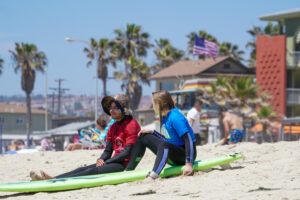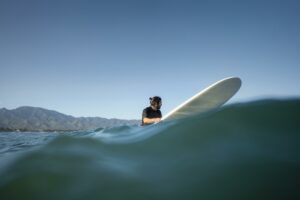The Fish Surfboard
The most dynamic shape of any surfboard design is the fish. The fish is an easy shape for a learning surfer to control as opposed to a narrow performance shortboard. It would be very difficult for an individual who is improving their surfing skills to jump from a mid -length board to a shortboard. The fish provides a perfect step in between the two levels, easing someone on to a shorter board while providing some extra cushion with the width and paddle power a fish will provide.
A fish surfboard may seem a little unusual or unheard of because of the lack of use in professional competitions; however, this board can help you build skills.
Fish surfboards are for any age that starts progressing beyond beginner into a more immediate skill level. Since these boards are thicker and paddle along easier than other boards, they work well in smaller and calmer waters.
Fish Board Shape
Fish surfboards are often beautiful looking. The retro style of the board is an eye-catcher for even non-surfers. The boards are typically conversation pieces as well as being a respected weapon in any lineup. Surfing a fish pays homage to the old-school rippers who first paddled out on a swallow tail twin fin decades ago.
When a surfer begins to explore the shorter board circuit and new ways of growth, fish board surfing is the place to start. Sometimes on a beach break or even on the mellow reefs, a fish surfboard is just about the only way to surf it well.
The wider tail on a fish surfboard makes driving the line smoother and better. Since it is not as short as a shortboard, the fish surfboard is perfect for the in-between when transitioning from a longboard.
Fish Board Sizes
Fish boards can be anywhere from five feet to nine feet long and should typically be a couple of inches shorter than your height (but this depends on the skill and comfort of the surfer). Fish surfboards are not one size fits all, just like any other surfboard.
It is good to have a sense of your ability and the size of your longboard. Board length depends heavily on your height but also your weight. The more skilled you are, the shorter your board can be.
If you are new to surfing, do not let the size of the board intimidate you. If your pop-up is solid and consistent on a bigger board, try your luck with a nice wide fish. You will likely surprise yourself with your ability to perform on something shorter and wider than what is familiar to you. Just be prepared to handle a bit more instability while paddling, and remember to pop-up quickly!
The Benefits of Using a Fish Surfboard
There are benefits and disadvantages to using a fish surfboard instead of a longboard or a shortboard. The most basic level of using a fish surfboard is beneficial in four ways:
- Speed
- Size
- Mobility
- Adaptability
The shape of a fish surfboard encourages speed and agility. It is smaller and better suited for more fins, which allows the board to be more mobile and adaptable. A fish surfboard can ride the most mellow and lackluster waves because it picks up speed and handles moves well.
The fish surfboard is more challenging to ride than a longboard; however, it provides more challenges, speed, and flexibility. The smaller size allows more room while transporting other things and makes it easier to travel with.
What’s the Big Deal About a Fish Surfboard?
Fish surfboards are incredibly versatile and unique. They are smaller and more portable while utilizing a fish-tailed design that can make adding fins smoother. While they are not the most mobile of boards, the shortened length and shape overall bolster the speed and have better buoyancy.
Fish boards may not be used in competitions often but can be used in practically almost any surf condition. They perform best in shallows but are just as fun in deeper water, and even flat and weak waves are fun with a fish surfboard.
When Should a Fish Board be Used?
Since fish boards are excellent at picking up speed, they work best in weak, small surfs. Fish board surfing is easier in the flatter waves that often overwhelm the summer months. It is easy to gain momentum even in the flat surf with this shape.
Even though the fish surfboard does well in flat waves, the board’s shape and design make it so you can ride almost any wave in practically any situation. While it may not perform the best in overly large waves, it will add speed to any wave you catch, even if it is just a foot or two.
A fish surfboard can be challenging to turn and move despite the versatility and flexibility the board provides. It is harder to gain control for tighter moves as the board gains speed so quickly.
Final Thoughts
Personally, I love fish boards, and the flowing style of surf that is always effective on this shape. If you are at all curious, hop on a fish and get yourself into a few fun nuggets. I doubt you will be at all disappointed.
When used correctly, the fish surfboard not only enhances a surfer’s ability but also provides an additional tool to use. Fish board surfing is ideal for small waves and can make a calm day fun since they quickly gain speed.
Teaching yourself is a rough road riddled with learning the hard way. Give yourself the right tools and firm foundation today by taking surfing lessons with Pacific Surf School. Our instructors are skilled and experienced to help you succeed.
If you are looking for any helpful tips or advice to improve your ability to ride a fish, or your overall surfing ability, reach out to us here at Pacific Surf!
Blog: Pacificsurf.com/blog
Instagram: @pacificsurfsandiego




